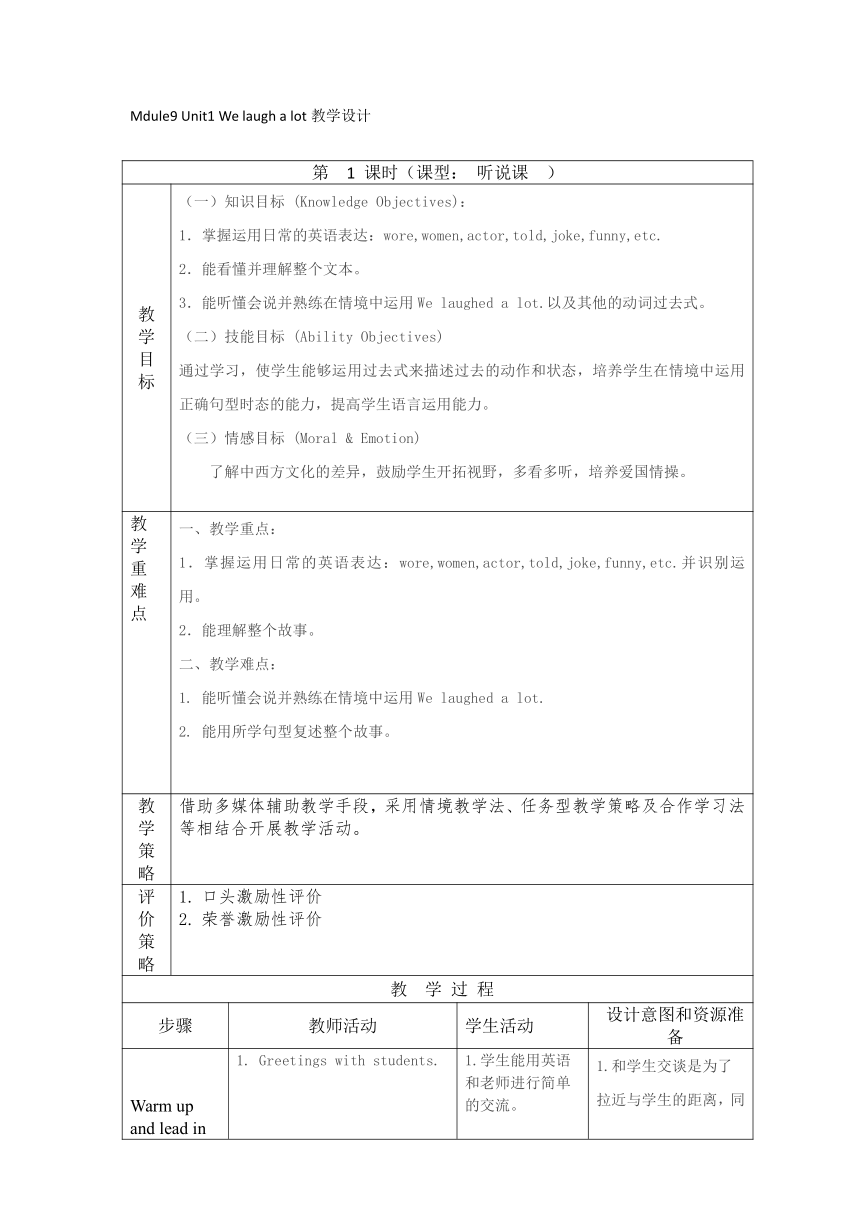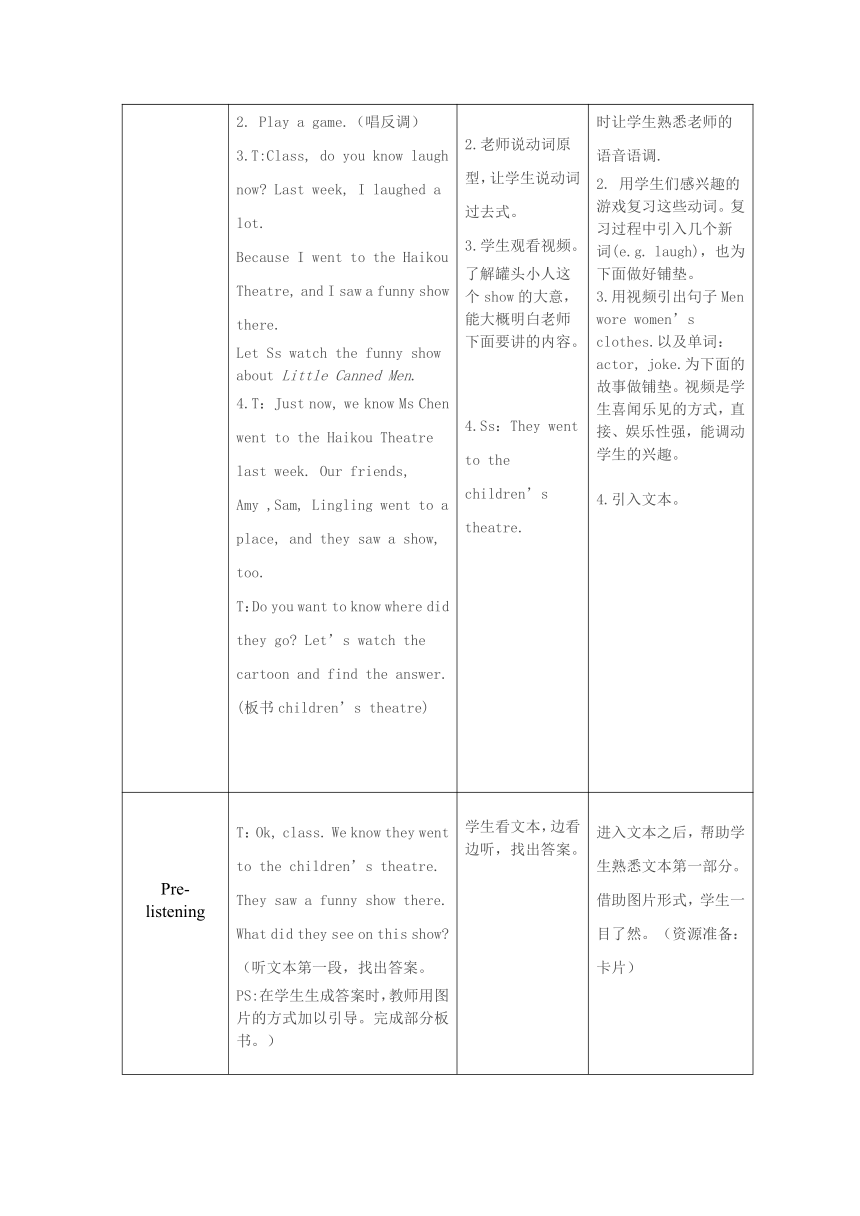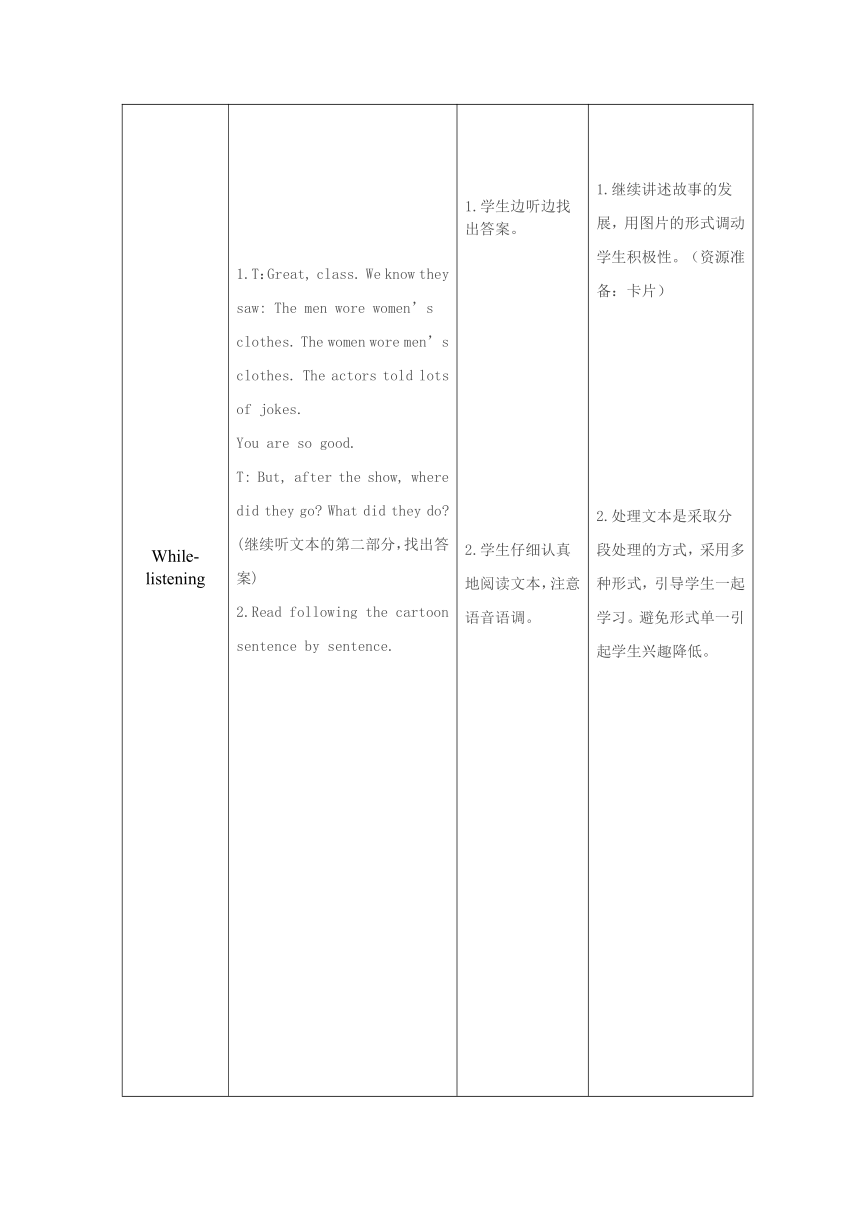Mdule9 Unit1 We laugh a lot表格式教案
文档属性
| 名称 | Mdule9 Unit1 We laugh a lot表格式教案 |  | |
| 格式 | zip | ||
| 文件大小 | 189.6KB | ||
| 资源类型 | 教案 | ||
| 版本资源 | 外研版(三年级起点) | ||
| 科目 | 英语 | ||
| 更新时间 | 2023-01-28 16:22:33 | ||
图片预览



文档简介
Mdule9 Unit1 We laugh a lot教学设计
第 1 课时(课型: 听说课 )
教学目标 (一)知识目标 (Knowledge Objectives): 1.掌握运用日常的英语表达:wore,women,actor,told,joke,funny,etc. 2.能看懂并理解整个文本。 3.能听懂会说并熟练在情境中运用We laughed a lot.以及其他的动词过去式。 (二)技能目标 (Ability Objectives) 通过学习,使学生能够运用过去式来描述过去的动作和状态,培养学生在情境中运用正确句型时态的能力,提高学生语言运用能力。 (三)情感目标 (Moral & Emotion) 了解中西方文化的差异,鼓励学生开拓视野,多看多听,培养爱国情操。
教学重难点 一、教学重点: 1.掌握运用日常的英语表达:wore,women,actor,told,joke,funny,etc.并识别运用。 2.能理解整个故事。 二、教学难点: 1. 能听懂会说并熟练在情境中运用We laughed a lot. 2. 能用所学句型复述整个故事。
教学策略 借助多媒体辅助教学手段,采用情境教学法、任务型教学策略及合作学习法等相结合开展教学活动。
评价策略 口头激励性评价 荣誉激励性评价
教 学 过 程
步骤 教师活动 学生活动 设计意图和资源准备
Warm up and lead in Greetings with students. 2. Play a game.(唱反调) 3.T:Class, do you know laugh now Last week, I laughed a lot. Because I went to the Haikou Theatre, and I saw a funny show there. Let Ss watch the funny show about Little Canned Men. 4.T:Just now, we know Ms Chen went to the Haikou Theatre last week. Our friends, Amy ,Sam, Lingling went to a place, and they saw a show, too. T:Do you want to know where did they go Let’s watch the cartoon and find the answer. (板书children’s theatre)
1.学生能用英语和老师进行简单的交流。 2.老师说动词原型,让学生说动词过去式。 3.学生观看视频。 了解罐头小人这个show的大意,能大概明白老师下面要讲的内容。
4.Ss:They went to the children’s theatre. 1.和学生交谈是为了拉近与学生的距离,同时让学生熟悉老师的语音语调. 用学生们感兴趣的游戏复习这些动词。复习过程中引入几个新词(e.g. laugh),也为下面做好铺垫。
3.用视频引出句子Men wore women’s clothes.以及单词:actor, joke.为下面的故事做铺垫。视频是学生喜闻乐见的方式,直接、娱乐性强,能调动学生的兴趣。 4.引入文本。
Pre- listening T:Ok, class. We know they went to the children’s theatre. They saw a funny show there. What did they see on this show (听文本第一段,找出答案。 PS:在学生生成答案时,教师用图片的方式加以引导。完成部分板书。) 学生看文本,边看边听,找出答案。 进入文本之后,帮助学生熟悉文本第一部分。借助图片形式,学生一目了然。(资源准备:卡片)
While- listening 1.T:Great, class. We know they saw: The men wore women’s clothes. The women wore men’s clothes. The actors told lots of jokes. You are so good. T: But, after the show, where did they go What did they do (继续听文本的第二部分,找出答案) 2.Read following the cartoon sentence by sentence. 1.学生边听边找出答案。 2.学生仔细认真地阅读文本,注意语音语调。 1.继续讲述故事的发展,用图片的形式调动学生积极性。(资源准备:卡片) 2.处理文本是采取分段处理的方式,采用多种形式,引导学生一起学习。避免形式单一引起学生兴趣降低。
Post- listening For the first time,let Ss read by themselves. If they have any questions, they can ask the teacher. 2.The teacher prepares some pictures and help Ss describe. Then teacher asks Ss come to the front and describe these pictures by themselves. In other way, Ss try to retell the story. 3.T:We know our friends went to the children’s theatre. They saw a funny show. How about these children (课件呈现Part 4 图片,Pair work, 一问一答。) 4.T:Class, you are so great. I went to the Haikou Thratre. Lingling went to the children’s theatre. These children played football, swam and flew kites. What did you do (小记者接力,一问一答,了解同学的周末。) 学生遇到不会的词大胆地举手询问。 学生观察教师提供的图片,用学过的句型来描述图片。
同桌合作,说出做了某事。 4.同学自己挑选朋友询问。 学生通读文本,真正了解文本,找出重点,不停操练。 2.以图片的形式来复述故事,这是文本简单化的一种途径,学生只需描述出重点句型即可。 3.同桌活动,描述途中小朋友上周做了什么,操练重点句型,为后面的拓展环节做铺垫。 4.小记者接力,充分调动学生积极性,帮助学生将英语运用到日常生活中。
Summary PPT出示: Dear , Last week we went to a children’s .The men were. The women were. The actors told lots of . It was very funny. We laughed a lot. Children here love the theatre. After the show. we went to a . We all ate . Are you ready for your trip to the US From, 升华:Joys shared with others are more enjoyed. (与众同乐,其乐更乐)。 利用填空的方式,整体回忆课文,加深理解,同时检测学生在本节课中对单词、句子的掌握程度。
作业设计 1.认读、识记本节课学习的动词的过去式,建议学生做成小册子以便随时记忆复习。 2.利用课堂总结模板识记课文。
板书设计 Module9 Unit 1 We laughed a lot. get were went to saw were told X laughed funny
第 1 课时(课型: 听说课 )
教学目标 (一)知识目标 (Knowledge Objectives): 1.掌握运用日常的英语表达:wore,women,actor,told,joke,funny,etc. 2.能看懂并理解整个文本。 3.能听懂会说并熟练在情境中运用We laughed a lot.以及其他的动词过去式。 (二)技能目标 (Ability Objectives) 通过学习,使学生能够运用过去式来描述过去的动作和状态,培养学生在情境中运用正确句型时态的能力,提高学生语言运用能力。 (三)情感目标 (Moral & Emotion) 了解中西方文化的差异,鼓励学生开拓视野,多看多听,培养爱国情操。
教学重难点 一、教学重点: 1.掌握运用日常的英语表达:wore,women,actor,told,joke,funny,etc.并识别运用。 2.能理解整个故事。 二、教学难点: 1. 能听懂会说并熟练在情境中运用We laughed a lot. 2. 能用所学句型复述整个故事。
教学策略 借助多媒体辅助教学手段,采用情境教学法、任务型教学策略及合作学习法等相结合开展教学活动。
评价策略 口头激励性评价 荣誉激励性评价
教 学 过 程
步骤 教师活动 学生活动 设计意图和资源准备
Warm up and lead in Greetings with students. 2. Play a game.(唱反调) 3.T:Class, do you know laugh now Last week, I laughed a lot. Because I went to the Haikou Theatre, and I saw a funny show there. Let Ss watch the funny show about Little Canned Men. 4.T:Just now, we know Ms Chen went to the Haikou Theatre last week. Our friends, Amy ,Sam, Lingling went to a place, and they saw a show, too. T:Do you want to know where did they go Let’s watch the cartoon and find the answer. (板书children’s theatre)
1.学生能用英语和老师进行简单的交流。 2.老师说动词原型,让学生说动词过去式。 3.学生观看视频。 了解罐头小人这个show的大意,能大概明白老师下面要讲的内容。
4.Ss:They went to the children’s theatre. 1.和学生交谈是为了拉近与学生的距离,同时让学生熟悉老师的语音语调. 用学生们感兴趣的游戏复习这些动词。复习过程中引入几个新词(e.g. laugh),也为下面做好铺垫。
3.用视频引出句子Men wore women’s clothes.以及单词:actor, joke.为下面的故事做铺垫。视频是学生喜闻乐见的方式,直接、娱乐性强,能调动学生的兴趣。 4.引入文本。
Pre- listening T:Ok, class. We know they went to the children’s theatre. They saw a funny show there. What did they see on this show (听文本第一段,找出答案。 PS:在学生生成答案时,教师用图片的方式加以引导。完成部分板书。) 学生看文本,边看边听,找出答案。 进入文本之后,帮助学生熟悉文本第一部分。借助图片形式,学生一目了然。(资源准备:卡片)
While- listening 1.T:Great, class. We know they saw: The men wore women’s clothes. The women wore men’s clothes. The actors told lots of jokes. You are so good. T: But, after the show, where did they go What did they do (继续听文本的第二部分,找出答案) 2.Read following the cartoon sentence by sentence. 1.学生边听边找出答案。 2.学生仔细认真地阅读文本,注意语音语调。 1.继续讲述故事的发展,用图片的形式调动学生积极性。(资源准备:卡片) 2.处理文本是采取分段处理的方式,采用多种形式,引导学生一起学习。避免形式单一引起学生兴趣降低。
Post- listening For the first time,let Ss read by themselves. If they have any questions, they can ask the teacher. 2.The teacher prepares some pictures and help Ss describe. Then teacher asks Ss come to the front and describe these pictures by themselves. In other way, Ss try to retell the story. 3.T:We know our friends went to the children’s theatre. They saw a funny show. How about these children (课件呈现Part 4 图片,Pair work, 一问一答。) 4.T:Class, you are so great. I went to the Haikou Thratre. Lingling went to the children’s theatre. These children played football, swam and flew kites. What did you do (小记者接力,一问一答,了解同学的周末。) 学生遇到不会的词大胆地举手询问。 学生观察教师提供的图片,用学过的句型来描述图片。
同桌合作,说出做了某事。 4.同学自己挑选朋友询问。 学生通读文本,真正了解文本,找出重点,不停操练。 2.以图片的形式来复述故事,这是文本简单化的一种途径,学生只需描述出重点句型即可。 3.同桌活动,描述途中小朋友上周做了什么,操练重点句型,为后面的拓展环节做铺垫。 4.小记者接力,充分调动学生积极性,帮助学生将英语运用到日常生活中。
Summary PPT出示: Dear , Last week we went to a children’s .The men were. The women were. The actors told lots of . It was very funny. We laughed a lot. Children here love the theatre. After the show. we went to a . We all ate . Are you ready for your trip to the US From, 升华:Joys shared with others are more enjoyed. (与众同乐,其乐更乐)。 利用填空的方式,整体回忆课文,加深理解,同时检测学生在本节课中对单词、句子的掌握程度。
作业设计 1.认读、识记本节课学习的动词的过去式,建议学生做成小册子以便随时记忆复习。 2.利用课堂总结模板识记课文。
板书设计 Module9 Unit 1 We laughed a lot. get were went to saw were told X laughed funny
同课章节目录
- Module 1
- Unit 1 We lived in a small house.
- Unit 2 She didn't have a television.
- Module 2
- Unit 1 She learnt English.
- Unit 2 Mr Li was a teacher.
- Module 3
- Unit 1 She had eggs and sausages.
- Unit 2 Sam ate four hamburgers.
- Module 4
- Unit 1 Let's make a home library.
- Unit 2 We can find information from books and CDs.
- Module 5
- Unit 1 It's big and light.
- Unit 2 It's too big for you.
- Module 6
- Unit 1 I went there last year.
- Unit 2 She visited the Tianchi Lake.
- Module 7
- Unit 1 My father goes to work at eight o'clock eve
- Unit 2 I'll be home at seven o'clock.
- Module 8
- Unit 1 Will you help me?
- Unit 2 I made a kite.
- Module 9
- Unit 1 We laughed a lot.
- Unit 2 Mum bought new T-shirts for you.
- Module 10
- Unit 1 Where are you going to go?
- Unit 2 I'm in New York now.
- Review Module
- Unit 1
- Unit 2
